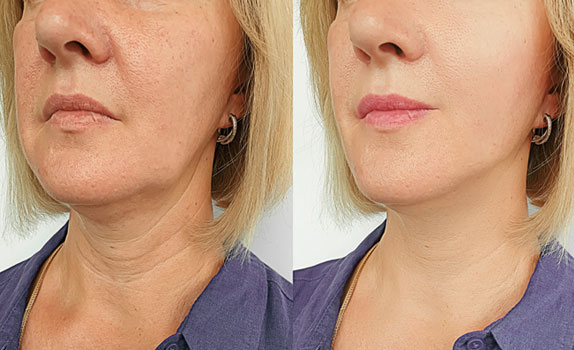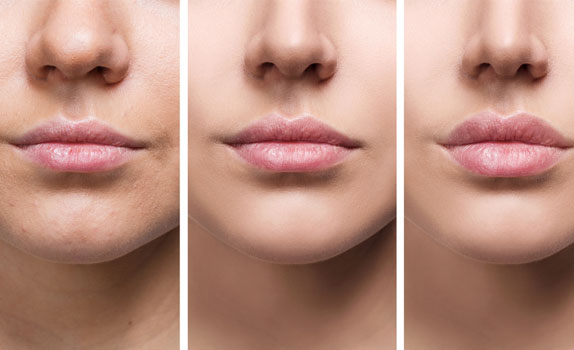Dermal fillers aren't the same as neurotoxins like Botox and Dysport. The latter type "freezes" muscles to reduce wrinkles, while fillers smooth out skin by filling wrinkles. Collagen used to be a common filler, but these days most fillers, such as Restylane and Juvéderm, use hyaluronic acid. Thanks to its ability to store moisture, hyaluronic acid is responsible for giving skin a plump, hydrated look.


FAQs
What is Hyaluronic acid?
Young skin is smooth and elastic because it contains large amounts of hyaluronic acid. As we age, the amount of HA in the skin gradually diminishes. As a result, the skin becomes dryer, thinner and more wrinkled. The filler products which are used at our clinic are a long-lasting but not permanent synthetic form of hyaluronic acid. The gel mimics the naturally occurring substance by adding volume to the skin. When fillers are injected under the surface of the skin, the gel adds volume and smoothes facial lines and folds.
How does it work?
A small amount is injected directly into the skin to add volume and restore hydration. HA is naturally integrated into the tissue and allows for the free passage of important nutritive elements like oxygen and hormones. The product will also bind water, which adds to the filling effect.
What are fillers used for?
Different fillers are used for specific areas of the face. For instance, the product which will be best suited to improve the cheeks is not quite the same as the ones that are used for more superficial lines or the lips.
Fillers are often used to correct the “nasolabial folds” which occur from the wing of the nose to the angle of the mouth, and “marionette lines” which are furrows just below and to the side of the mouth. The contours of the lips can be enhanced to the desired level by accentuating the vermillion border and giving the lips more volume. Cheeks which have become flattened by the aging process can be lifted beautifully using filler. Very deep wrinkles and some types of acne scars cannot typically be treated with this material. Very superficial wrinkles are often difficult to correct.
Do the injections hurt?
Pain is very individualized and dependant on one’s tolerance to pain. Prior to treatment a topical anesthetic cream can be applied, which takes about 20 minutes to take effect. Or in some instances pain can be improved through the use of a nerve block similar to what you may have experienced at the dentist’s office.
What is involved in a dermal filler treatment session?
The treatment typically takes about 15-45 minutes depending on the area treated and the number of syringes used. Filler is injected with a very thin needle into the skin. Some results are visible immediately.
Can fillers replace surgical procedures?
No. People with excess facial skin or people who want a major resurfacing of the skin cannot be corrected with fillers alone.
Can the material be removed?
Hyaluronic Acid Fillers are a natural material, so they dissolve with time. In the event that you feel uncertain about the desired result or there is an unexpected complication, there is a medication called hyaluronidase which can be of assistance.
Does it contain animal products?
No, the hyaluronic acids which are available in Canada are almost identical to that already present in the body. Since it is not made from animals, there is no risk of transmitting diseases from animals, or eliciting allergic reactions to common foodstuffs such as eggs, meat or chicken.
Are there any precautions I should take before treatment?
Yes. If you are on any medication that causes bruising, you should stop taking them 3-5 days before treatment. This may include ASA (aspirin), Advil, Motrin and other prescription medication. Please check with your injector and/or your family doctor prior to discontinuing any medication that is prescribed for you. Also, some vitamins such as Vitamin E, Ginkco, Garlic, Ginseng, St. Johns Wort, and Omega 3’s can increase bruising.
How long does the effect last?
The filler dissolves naturally with time, and without touch-ups will eventually totally disappear from the body. How long a hyaluronic acid filler treatment lasts is very individual, depending on many factors such as the structure of the skin, lifestyle, age and metabolism. However, for the majority, about 50-80% of the effect remains after six months. The injected material will gradually disappear until your skin looks just as it did before the treatment. You can replenish the filler whenever you feel the need or ask your provider his/her opinion.
Great skin doesn't happen by chance, it happens by appointment.
Hurry, your new skin is waiting. Schedule an appoinment for your initial consult today.